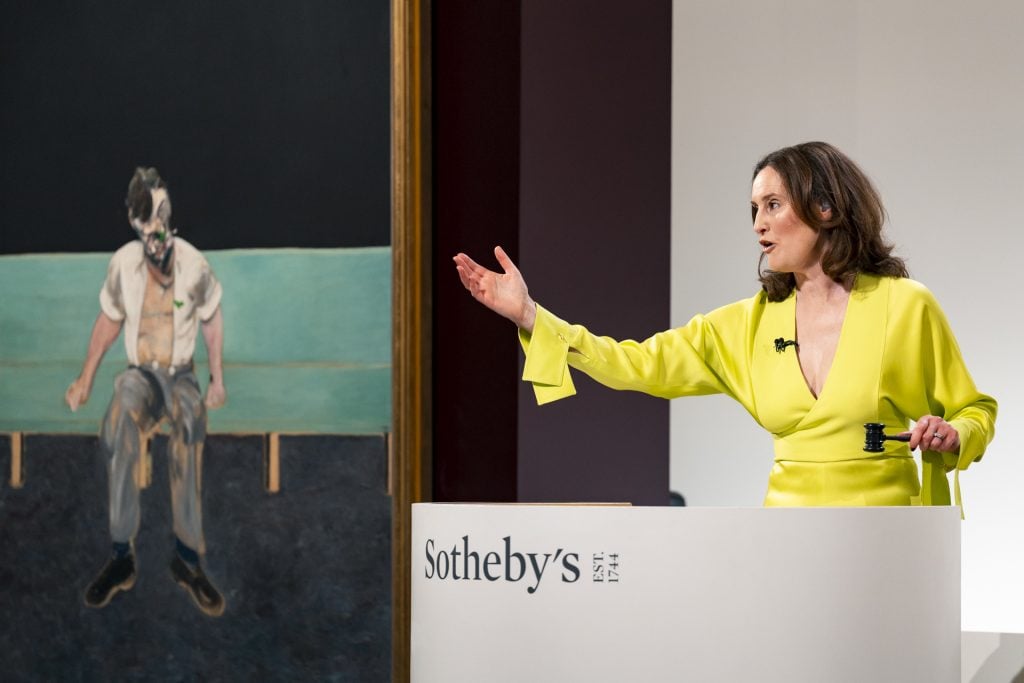Auctions
Sotheby’s U.K. Profit Dropped by 24 Percent Last Year, With Brexit the Likely Culprit
"The increased red tape resulting from Brexit is...further contributing to the U.K. art market's decline."

"The increased red tape resulting from Brexit is...further contributing to the U.K. art market's decline."

Vivienne Chow

Sotheby’s reported a 24 percent year-on-year decline in profit for its U.K. operation in 2022, citing art market and global economic uncertainties, as well as increased red tape as a result of Brexit, according to the auction house’s latest Companies House filings in the U.K.
The filing, made on July 19, which the Art Newspaper first reported, showed that the auction house’s U.K. arm recorded an after-tax profit of £26.2 million 2022, against 2021’s £34.5 million. Overall turnover, however, was only down by 2 percent to £150.9 million in 2022, from 2021’s £154.8 million.
Sotheby’s is no longer a listed, or publicly traded, company.
While turnover from auction revenue generated in the U.K. dipped to £131.4 million in 2022 from 2021’s £135.7 million, turnover from private sales increased slightly from £19 million to nearly £19.6 million. The increase came mainly from the U.K. and Europe. Private sales turnover originated in the U.S. last year was only 36 percent of 2021’s amount, and that from Asia was down by more than 50 percent.
When reached for comment, Sotheby’s said that the data included in Companies House filings did not present a full picture. “This is incomplete data based on a standalone entity which does not represent the financial view of our full global enterprise or even our U.K. business in aggregate,” the auction house told Artnet News in a statement. “Last year, Sotheby’s London posted its highest consolidated sales since 2018, reaching $1.4 billion. And, based on Sotheby’s London year-to-date figures for 2023, the company is on track to exceed this figure this year.”
Increase in cost of sales as well as administrative expenses appear to be the biggest contributors to the decline in profit, according to the filings. The cost of sales was up by nearly 55 percent to £25.4 million from 2021’s £16.4 million. Administrative expenses increased by 2 percent year on year to £106 million in 2022.
Brexit was cited as driving the surge in costs, the filings show. Brexit “has increased volatility and uncertainty in global financial markets, economic conditions, and Pound Sterling exchange rates,” which may all impact the demand and supply of discretionary goods, a statement reads.
Sotheby’s responded that “the Brexit reference [in filings] is a risk disclosure which various U.K. companies will have had listed…to interpret these risk factors as an ‘explanation’ for any business operations is to misinterpret the purpose of their inclusion in the accounts.”
The U.K’s imports of art and antiques went down by 18 percent in 2021 compared to that in 2020, and a further decrease by 16 percent in 2022, “and this may worsen over time,” the statement read. “The increased red tape resulting from Brexit is adversely impacting our ability to move property between the U.K. and the European Union and the retention and travel of our employees, further contributing to the U.K. art market’s decline.”
Selling works in the U.K. also became less appealing due to those administrative burdens and higher import and export taxes and other duties, and as a result, the amount and quality of consignments for the London saleroom was “negatively affected.”
There has not been a comprehensive report on how Brexit has affected the U.K.’s art market, which was the world’s second biggest in 2022, accounting for 18 percent share of global sales, according to data from a UBS and Art Basel report. But E.U.-based dealers previously told Artnet News during London’s Treasure House Fair that bringing art to London had cost them 20 percent more compared to pre-Brexit days.
The war in Ukraine had no direct impact on the operations of Sotheby’s U.K., according to the filings. Sotheby’s said Russian clients represented less than one percent of the house’s global client activity in 2022 and 2021. The house and its subsidiaries do not host sales in Russia and an administrative office in Moscow was closed following the outbreak of the war. The auction house has ensured full compliance of the legal requirements and sanctions imposed in light of the situation.
More Trending Stories:
JTT, the New York Gallery Known for Minting Star Artists, Is Closing After More Than a Decade